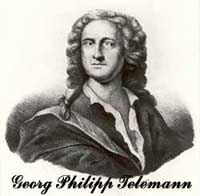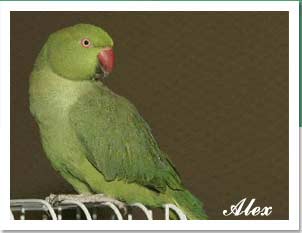Birds and Music:
Expressions of Humor and Sorrow
by Jonathan Harris, Mal Raff, and Chloe Redon
The German composer Georg Philipp Telemann wrote a funeral cantata for a singing canary that was killed and eaten by a cat. Telemann (1681-1767) was the most popular composer in Germany during the first half of the 18th century. His fame eclipsed even that of his contemporary J.S. Bach.
We know little or nothing about the genesis of the Canary Cantata, "Cantata oder Trauer-Musik eines kunsterfahrenen Kanarien-Vogels, als derselbe zum grÃssten Leidwesen seines Herrn Possessoris verstorben" (Cantata or Funeral Music for an Artistically Trained Canary Whose Demise Brought the Greatest Sorrow to his Master). The work dates from around 1737, the middle of Telemann's life. There is some speculation he wrote it for a friend or commission for a patron whose beloved canary had been killed.
Nowadays, people tend to interpret it ironically and perform it mostly for laughs. Indeed, there is some ambiguity in the "affect" (feeling) of the work. The cat who killed and ate the bird is roundly cursed in a couple of arias, and because the cantata ends with such a curse, it's easy enough to imagine the composer may have been writing a bit tongue in cheek, adding a light touch, and creating a "tragic-comic" work. But that may be hearing it with a 20th/21st-century ear. The cantata's ambiguity of affect may be real and, if so, perhaps expresses a deeper ambivalence toward its subject, rooted in a religious culture that believes that animals have no souls. In this context, one might feel pity for a dead bird, something only permissible as sorrow over the loss of a beautiful thing of this world, something which inevitably must be relinquished.
Another musical tale from a half-century after Telemann's cantata perfectly illustrates the mixing of humor with sorrow. In 1784, Wolfgang Amadeus Mozart bought a starling from a Vienna pet shop because, he wrote in his journal, he heard it whistle a theme from a piano concerto he had just composed. How the bird could have learned this melody, and whether it was in fact from Mozart's concerto or just something very similar, have been matters of speculation; but Mozart himself (who had an awfully good ear) was convinced it was the real thing.
The starling lived in Mozart's flat for 3 years, and when it died in 1787, he gave the bird a huge funeral, involving a procession with hymns and paid mourners. Mozart wrote and recited a poem for the occasion. Some writers have seen this as evidence of his emotional immaturity; others have suggested it involved displaced grief over the recent death of his father, with whom the composer had a difficult relationship and whose passing a week earlier he had barely noted. Possibly, but maybe the scholars who spun those theories were not bird lovers, missing perhaps the simplest explanation—that Mozart had bonded with the bird and sincerely grieved at its death.
Mozart's commemorative poem is semi-humorous. He imagines the bird up in the heavens now, praising him "without pay." And he opens the verse by calling him "a little fool." The German word he uses, however, "Narr," also could be translated as joker or jester - a quality Mozart certainly saw and valued in himself.
The first composition Mozart completed after the starling's funeral (barely a week later) was "A Musical Joke." The piece satirizes small-town musicians and is quite funny—deliberately amateurish, incompetent in places, banal in others, and over-the-top pretentious in still others. Mozart also writes in horrible mistakes and, because the music is performed with repeats, you hear the musicians do exactly the same awful things again.
Ornithologists Meredith West and Andrew King have studied this work and believe Mozart was deliberately incorporating his starling's musical style into it. Excerpting and paraphrasing from their 1990 essay, they see the signature of a starling's music in Mozart's "illogical piecing together" of musical material, which they say is in keeping with the way starlings sometimes intertwine whistled tunes—also in his "awkward fracturing of musical phrases at unexpected points" and in his "drawn-out, wandering phrases of uncertain structure" (especially in one overly-long cadenza), which they claim to be characteristic of starling soliloquies. Something else they note is that the late musicologist Alan Tyson believed that "A Musical Joke," although completed just 8 days after the starling's funeral, was composed in fragments between 1784 and 1787 - the period exactly coinciding with the starling's life. Tyson also identified an excerpt in the piece quoted from the same piano concerto that the starling whistled.
If you want to read their whole article, see:
- http://www.starlingtalk.com/mozart4.htm
- Also see David Rothenberg's book, 'Why Birds Sing,' Chapter 9.
According to one of our fellow volunteers, there is a lot of truth in the above:
“All of that would go along with my observations of our starling during the 16 years he was with us. He did make some notable non-starling sounds, along with a few words and phrases... but he would also 'sing', incorporating some of his 'other sounds', apparently at random, amidst his song. He always had a 'theme' which sounded at least partly like normal outdoor starling sounds, but 'fractured' as you described. During his younger years, when he was flight-able, he would fly to my shoulder while I was playing the piano... and sing quite loudly in my ear... perhaps competing, perhaps contributing. But he was always the 'music' bird... turn on the stereo, music on TV or on the computer, and he was 'in there' improvising his own part. We do miss him...
Although most of my reports of the starling's musicality are anecdotal, they would seem to echo the more recent findings about Snowball, the 'dancing' cockatoo. We've seen similar sorts of things with other cockatoos, but nowhere near as synchronized.
A recent PBS show about music, and how and why it seems to have such a profound effect on humans, pointed out that apes do not seem to react, but that birds do. It would seem that we have more in common with birds (at least in the music area) than with other species.”

